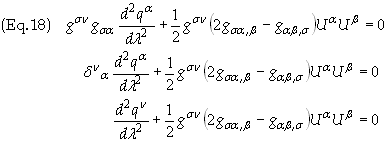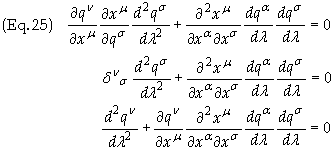Geodesics
Back
to Physics World
Back to Geometrical Math for GR
Straightest
Possible Line in a Curved Space
The first definition
states that a geodesic is the straightest possible line in a curved
space. Here we use affine geometry in which the space is explored
by parallel transport. The term affine means connected and
refers to how parallel lines are connected.
Let l be an affine
parameter which parameterizes the curve which is to be expressed in generalized
coordinates q. Then the geodesic can be defined by demanding parallel
transport of the tangent vector along the curve. I.e.
![]()
where
![]()
is the covariant derivative of Um. Note that according to the chain rule
![]()
Eq. (2) can now be
expressed as

Substituting
![]()
into Eq. (3) gives the
final result, i.e. the Geodesic Equation

Path of Extremal
Length
The second definition
states that a geodesic is
a path of extremal length. Here we use metric geometry in
which the space is explored by measuring distances. The term metric means 'to
measure' and we use it to measure the path which has an extreme length.
Let l be an affine
parameter, which parameterizes the curve that is to be expressed in generalized
coordinates qa. Consider the length of a curve as defined as the
integral of ds, where
where
ds2
= gabdqadqb and

where L is defined as
![]()
An integral is said to be extremal when its first variation vanishes, i.e. dS = 0. As such L satisfies the Euler-Lagrange Equations
![]()
Carrying out the
differentiation (note that gab is not a function of Um)
is a bit complicated but can be made simple by starting with L2
to obtain
![]()
We can now utilize Eq.
(10) to make things easy in the calculations to come.
![]()

where ![]() . dab
is the Kronecker
delta.
Therefore
. dab
is the Kronecker
delta.
Therefore

If l is chosen to
be arc length then ds = dl
from which it
follows
that
![]() and therefore L = 1. Taking the derivative of the first
term in Eq. (11) with respect to l
gives
and therefore L = 1. Taking the derivative of the first
term in Eq. (11) with respect to l
gives

Taking the derivative of the first term in Eq. (11) with respect to qs gives

In Eq. (13) we have used
the relation
![]() obtained above to simplify Eq.
(13). Substituting Eq. (12) and (13) into Eq. (7) gives
obtained above to simplify Eq.
(13). Substituting Eq. (12) and (13) into Eq. (7) gives
![]()
To put this in a more
familiar and compact form rewrite Eq. (14) as
![]()
Multiplying Eq. (11)
through by gsn
gives (note: gsngsm
= dnm
)

Since
![]() Eq. (11) can rewritten as
Eq. (11) can rewritten as
![]()
Relabel once more with n = m. Substitute the Christoffel symbols of the second kind, i.e.
![]()
![]()
Which, again, is the geodesic equation as derived at the top but now with a different, equivalent, definition.
Change
Coordinates from Locally Flat Coordinates
The third definition is similar to the first in that we define a geodesic, as the path, which is identical to zero acceleration of a point, as expressed in Cartesian coordinates equals zero. I.e. a straight line whose equation is given by
![]()
We now take that equation and express it in generalized coordinates. The Cartesian coordinates xa can be expressed in generalized coordinates xa = xa (qa). Substituting into Eq. (16) and applying the chain rule we get
![]()
Taking the second
derivative gives

Multiply through by ¶qn
/¶xm

where the relation
![]()
was employed to simplify Eq (25). It can be shown that
![]()
Substituting this expression into Eq. (16), and relabeling indices, once again yields
![]()
Back
to Geometrical Math for GR
Back to Physics World
![]()
![]()